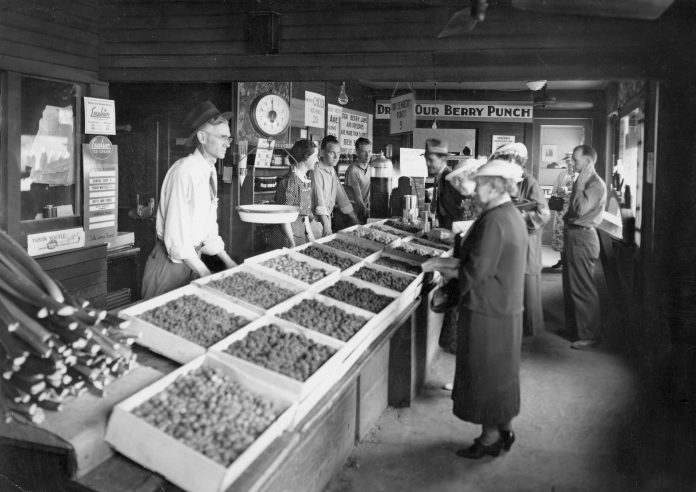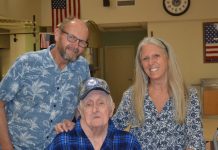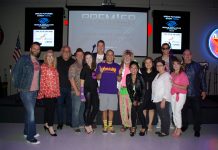
Fourth-generation local has an illustrious family history at Knott’s and in Orange County
By Brooklynn Wong
Orange County has changed a lot over the last century. What was once farmland has become suburbia; what was a homogenous post-war settlement has become multiracial; and what was a local stand to sell berries to families on their way to the beach has become an amusement park visited by millions each year.
One man, who has lived in the same home, blocks away from Knott’s Berry Farm for his entire life, has had a unique vantage point to the changes.
Dr. Kim Riddlebarger is a Buena Park lifer, spent years running a business at Knott’s, and his family roots run deep, as his relatives were around in the earliest days.
Knott’s Berry Farm, at the start, was just that. A man named Walter Knott and his wife Cordelia opened a berry stand. Beginning in the 1930s, Walter and Anaheim City Parks Superintendent and horticulturist Rudolph Boysen began selling the boysenberry, a hybrid fruit Boysen had created.
Riddlebarger says, “They patented it and it was doing pretty well, so Walter sold berries…while people were on their way to the beach from inland, because Highway 39 at the time—Beach Blvd. now—was a really big kind of access point to the beach.”
The area that is now the Grand Ave. and Crescent parking lot was the original boysenberry field.
“You’d have people on weekends going to local beaches, and they were looking for places to stop and so Walter opened the berry stand right there on the highway and the story goes, as the berry market started to do well, Walter thought, well, let’s have a restaurant, and really capitalized on it. So they built the Chicken Dinner Restaurant and even used Cordelia’s wedding china for their first serviettes in the restaurant.” It quickly expanded and became much more.
“Walter, who loved old western history, thought it would be really good to buy a bunch of western-themed stuff from the old ghost town at Calico, right up there by San Bernardino. And Walter brought in what’s now Ghost Town, and that succeeded so well that eventually they started adding rides and it became Knott’s Berry Farm over 25 years or so. I remember it being an amusement park as a kid, so say, by 1960.”
And Riddlebarger’s family was there almost from the very beginning. But his relatives were not only instrumental in the early days of Knott’s, but were prominent citizens in old Orange County.
To get the full picture, we must go back to the late 19th century.
His father’s family came to California in the 1880s and settled in Covina. His grandfather and grandmother met at the Brethren Church there “when he was 16 and she was 13, and their relationship got so close that my grandparents’ family moved them back to Idaho to break the relationship up, and he stayed in touch with her and they got married after he graduated from college. He went to what became UCLA. It was a teachers’ college. He then did his Master’s at USC and he was the first Superintendent of schools in Placentia. And then all around Southern California. Very prominent man. Glenn Riddlebarger was his name.”
And on the other side of the family, Kim’s maternal grandmother, Juliet Morris, “was one of the first schoolteachers in the city of Cypress. And she came in the teens.”
Across from Cypress Forest Lawn was a one-room schoolhouse where she was the teacher.
Ms. Morris soon met the farmer that lived across the street, Thomas, and they were wed and lived in Cypress.
“He owned a truck farm, a small ranch that is near the corner of Crescent and Moody, and what’s really funny about that is, part of the land that they owned is now part of Cypress Forest Lawn, and I’ve actually done funerals and buried people in what was my mom’s old ranch land. My mother would absolutely howl in laughter at that.”
But back in Buena Park, as Knott’s Berry Farm was beginning to materialize, and help was needed, the family’s next generation was on the scene.
“My aunt, my mom’s sister, her name was Virginia Morris….She was Walter Knott’s first secretary and she started at Knott’s, probably in the late ‘30s, and stayed on at Knott’s until she died in 1974.”
Soon after that his mother started working there as well.
“My mother’s name was Marian….She went to work at Knott’s in the berry market and she worked alongside Walter and Cordelia and their four children, Virginia, Marion, and Toni, and Walter’s son Russell….There she is, a girl of about 19, working in the berry market with them, so they go way way way back.”
And somewhat of a family legacy of matches made at Knott’s began with his parents. His father, Clayton, came to look for work at Knott’s, and “my mom saw him and liked his looks, so she had my Aunt Virginia hire him. They were married in Dec. of 1940.”
After taking time away from Knott’s to serve in the FBI during World War II, Clayton “settled in Lakewood and, given their connections to Mr. Knott—and my dad wanted to go into small business and didn’t want to work for the FBI—him and Mom approached Walter Knott, my guess is, ’46-’47, somewhere in there, right after the war, about doing the ceramic work for the Knott’s early gift packs, the jams the jellies.”
 Kim Riddlebarger’s aunt, Virginia Morris Birkinshaw, getting a service award from Walter Knott
Kim Riddlebarger’s aunt, Virginia Morris Birkinshaw, getting a service award from Walter Knott
Riddlebarger’s parents stayed in that line of work until 1955, then they turned over a new leaf.
“That year, my mom and dad approached Walter Knott about opening up a Christian bookstore at Knott’s Berry Farm, which was a pretty controversial thing. And Walter was kind of amenable to it, so he walked them out to a space which is now part of Camp Snoopy, and drew off a chunk of dirt in the ground that he thought could fit the store.”
The store, which would come to be called the Inspiration House, was added on to another business in the family.
“My other aunt, my mom’s younger sister Lue Morris, about 1950ish had opened a business at Knott’s called Art Glow Studio. Some people may remember it—they’d have to be really old now, but Art Glow was a place that sold fluorescent—obviously you walk in, and the lights would go off and you’d see the stuff glow and it was a big deal at the time but sounds hokey now. But the Inspiration House, the bookstore my folks opened, was built onto my aunt’s business.”
 The old Inspiration House and Art Glow Studio
The old Inspiration House and Art Glow Studio
When Art Glow Studio eventually closed, Walter Knott allowed the Christian bookstore to expand and use the entire space, and with a facelift too.
They “completely remodeled it into a really beautiful Spanish-style mission-type fixture….I mean it was really a nice, nice shop.”
The store remained at that location until 1969, when Clayton died unexpectedly at the age of 50.
Riddlebarger’s own involvement at Knott’s began when he was 14, working at various shops on the grounds, then beginning to work with his parents in his late teens. When he graduated from college at Cal State Fullerton, he interviewed with several manufacturing companies, but “wasn’t really sure what I wanted to do. I got callbacks on all of them. I think I could have gotten any one of them, but just my heart wasn’t in it.”
His mother gave him some sage advice, telling him to simply work in the family shop for the summer, and spend some time pondering what he wanted to do.
Riddlebarger says, “So after working in the bookstore, after being my own boss, I decided I liked that a lot better than working for somebody else. So I stayed on and my mom and I split the owner-manager duties.”
That set the stage for Riddlebarger match number two to be made at Knott’s. Kim had been approached by several people about beginning an employee Bible Study. He did, and the first time the group gathered, he spotted a familiar young woman. He and she—Micki was her name—had gone to school together.
“I was a year ahead of her. We were in a combination fifth and sixth grade class together. So I knew of her. I knew her boyfriends….[our families] only lived a couple blocks apart. And to see her at the Bible Study was kind of a surprise, and she was equally surprised to see me. I had been pretty wild in high school. Well, not awful, but, you know, usual high school prankster stuff, and she was pretty surprised to see me. So we started working together on various projects, and ended up getting married in 1978. So my folks met there and Mick and I met there.”
In 1984, Marion Knott approached Kim and his mother about the plans to build Camp Snoopy. He thought their days in business might be done, but instead Marion offered them an even sweeter deal. She offered a change of scenery, out onto Grand Ave., into what is now the candy shop.
“People asked me, ‘What’s your marketing philosophy?’” says Riddlebarger. “I would say, ‘Open the doors and turn on the lights.’ Because three million people walk by your front door per year. You don’t have to do a whole lot.”
There were still family members all over Knott’s at the time, with Kim’s wife, mother-in-law, mother, sister, and cousin working in various capacities at the park.
But times began changing in the early ’90s when Kim’s mother died, and a natural fork in the road presented itself.
“It was pretty clear to me by the time my mom died I could no longer stay in that business. I had all kinds of issues with selling pictures of Jesus and the Christian music stuff I didn’t care for, and commercialization of the faith, and having to sell trinkets really bothered me. So I ended up closing the store in Jan. of 1995.”
Riddlebarger says he has only been back to Knott’s once since then, “and it isn’t because of any ill will, it’s just off my radar.”
Thus ended a stretch of roughly 60 years with one of Riddlebarger’s family members involved at Knott’s.
However he has stayed in the same Buena Park house he has lived in for his whole life, the one his father built.
His mother’s family bought property on Crescent Ave., where his grandmother and aunt originally lived along the front of their L-shaped property. The middle of the property was the workshop where his family made the ceramics for Knott’s in the ‘50s. And Kim’s family bought the area behind the workshop, where his father built a house in 1950.
He had lived at home and commuted for all of his schooling, for undergrad in Fullerton, then to the three other schools where he continued his studies across Southern California.
“So I worked [at Knott’s] full time, went to seminary full time. I don’t know how I did it, but I did. It was like being in the Army. I’m up at 5 in the morning, on the freeway by 6, in Escondido [at Westminster Seminary], get home here at 3 or 4 in the afternoon, work in the bookstore ’till closing.”
He and his wife went to work for Christians United for Reformation, and then as Executive Director of “White Horse Inn”, a radio show on church history and recovering the rich tradition and tenets of the Protestant faith, which he still appears as a regular guest on, before helping establish Christ Reformed Church, which today meets in Anaheim, and where he now serves as Senior Pastor.
But Riddlebarger loves Buena Park and won’t be surprised if he never leaves. As for the changes he has seen over his lifetime, he says Buena Park “was very rural. Not suburbia when I grew up. Crescent Ave. was a two-lane road with irrigation ditches on either side. There were remnants of an airfield across the street from us. Knott’s was beginning to be surrounded by track homes and small shopping centers, and Buena Park was mostly post-World War II suburbs. That’s how my wife’s family came here. My father-in-law was in Southern California for the war and liked the climate, so he moved from Nebraska and bought a house just down the street from us in 1955…so the kids I grew up with were all children of World War II and it was a middle class, safe, kind of a happy place to grow up, you know. It was a really good environment. Over the years Buena Park has come to reflect Orange County. It’s very multiracial and the good and the bad that goes with that….It was very much a post-World War II boom, a lot of aerospace workers, that kind of stuff. It was a real nice community, and it’s changed just like Orange County has. Very compacted, some parts gentrified, but mostly less expensive housing, strip malls, that kind of stuff.”
What keeps him in Buena Park, a stone’s throw away from the place his family has always been involved in but has changed dramatically, he says, is primarily his occupation. But also, “I’ve grown up here and raised my sons here and the way things are going, probably die here….I’d like to….It’s the house my dad built. As one old preacher actually put it, ‘There’s laughter in the walls.’ A lot of fond memories here. It’s been a great experience.”
It’s somewhat uncommon to find a fourth-generation resident of anywhere in today’s transitory world, but Dr. Riddlebarger has done it and found it rewarding. He has six great-grandparents who lived and/or are buried in Orange County, making him a fourth-generation Californian. You can’t read up on Knott’s Berry Farm history or Orange County history without coming across his surname or those of his relatives, as having contributed to local education or the local amusement park. Orange County, Buena Park, and Knott’s will never be what they were in their original state and will continue to change, but from where Riddlebarger stands, on the L-shaped lot in the home his father built, it’s still the best place to be.










